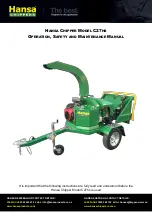
2.0 INSTALLATION
2.5 FOUNDATION
Refer to index for unit dimensions and load
points. Foundations must be level for proper
operation and functioning of controls and
provision must be made for supporting the
individual load points as shown in the unit
dimensions. Roof mounted units must be
supported on adequate steel structure. If units are
located on the ground level, a concrete base is
recommended.
2.6 VIBRATION ISOLATION
Under certain critical conditions. it may be
necessary to install vibration isolators under the
base of the packaged chiller.
Rubber-in-shear or spring vibration isolators are
offered as optional items. When spring isolators
are used, flexible connections must be installed
in the water piping system and in the refrigerant
lines of split systems. Note: These flexible
connectors must be suitable for the fluid and
pressures involved.
All piping which is external to the packaged
chiller must be supported by spring mounted
hangers and any piping which goes through the
wall, ceiling or floor should be properly sheathed
to prevent transmission of piping vibration to the
structure.
When spring isolators are used, electrical service
to the unit must also be flexibly connected by
means of a 36" section of flexible conduit.
2.7 PIPING CONNECTIONS
Refer to the dimensional drawings for water
piping connection locations. After the unit has
been leveled and isolators (if any) installed &
adjusted, connect evaporator water piping,
keeping in mind that the evaporator tubes may
require cleaning or replacement at some future
date, and removable sections of piping will be
required to permit evaporator head removal.
Piping must be supported to avoid excess stress
on the evaporator heads. Cut piping holes in the
removable access panel at the end of the unit.
Opening the hole to the left hand side of the
panel so that it can still be removed after piping
is in place. Holes can also be cut down through
the floor of the unit providing no cross-members
are cut out. Install air vent points to permit
complete air purging of the chilled water circuit.
Install drain valves in similar low points to
facilitate complete water system drainage. Install
temperature & pressure indicators in the water
piping at the unit to monitor water flow. Install
shut-off valves to isolate the unit from the piping
system during unit servicing. Note: Due to
possible high pressures resulting from rising
temperatures, do not close shut-off valves with
cold water in the evaporator.
It is important that the chilled water system be
cleaned before startup to avoid collecting debris
in the evaporator. After filling the system with
water (or a glycol solution), start pump, bleed off
trapped air, and check for proper flow rate by
measuring water pressure drop across evaporator.
NOTE: WATER QUALITY - ACXi
Evaporators used in these packages are made of
steel, copper and brass and are suitable for
operation with well-maintained water systems.
However, if the water used in evaporator is
corrosive, high in mineral content or entrained
solids, the water can cause reduced performance
and even failure of heat exchangers. Therefore, it
may be necessary to obtain the services of a
water treatment consultant and to provide and
maintain water treatment. This is particularly
important with glycol systems.
2.8 ELECTRICAL WIRING
In connecting power wiring to the unit, the
following precautions should be taken:
1.) All field wiring is to be in accordance with
the National Electric Code and must comply
with state and local codes. See Electrical
Data for minimum circuit ampacity and fuse
size.
- 10 -
Summary of Contents for ACXi 165-5SP-LN
Page 6: ...2 0 INSTALLATION FIGURE 2 3 2 ACXi 165 5SP LN TYPICAL RIGGING 6...
Page 14: ...3 0 OPERATION FIGURE 3 2 ACXi 165 5SP LN TYPICAL SCHEMATIC PIPING 14...
Page 20: ...CHECKED REV NO DATE APPROV 4 0 ELECTRICAL FIGURE 4 2 ACXi 165 5SP LN WIRING SCHEMATIC 20...
Page 21: ...4 0 ELECTRICAL 21...
Page 22: ...4 0 ELECTRICAL 22...
Page 23: ...4 0 ELECTRICAL 23...
Page 24: ...4 0 ELECTRICAL 24...
Page 25: ...4 0 ELECTRICAL 25...
Page 26: ...4 0 ELECTRICAL 26...
Page 27: ...4 0 ELECTRICAL 27...
Page 28: ...4 0 ELECTRICAL 28...
Page 29: ...4 0 ELECTRICAL 29...
Page 30: ...4 0 ELECTRICAL 30...
Page 31: ...4 0 ELECTRICAL 31...











































